Buniyar Temple
Buniyar temple is situated in Baramulla Uri
road on the bank of Vitasta. This temple as per the archeologists is the
best preserved specimen of the Kashmiri architecture. Although most of
the Kashmiri temples are made of lime stone, this temple is made from
granite rocks. The temple is now often described as Vishnu temple dating
back to 8th-12 century A.D. However now this place is a millitary camp
and is being taken care by the millitary men.
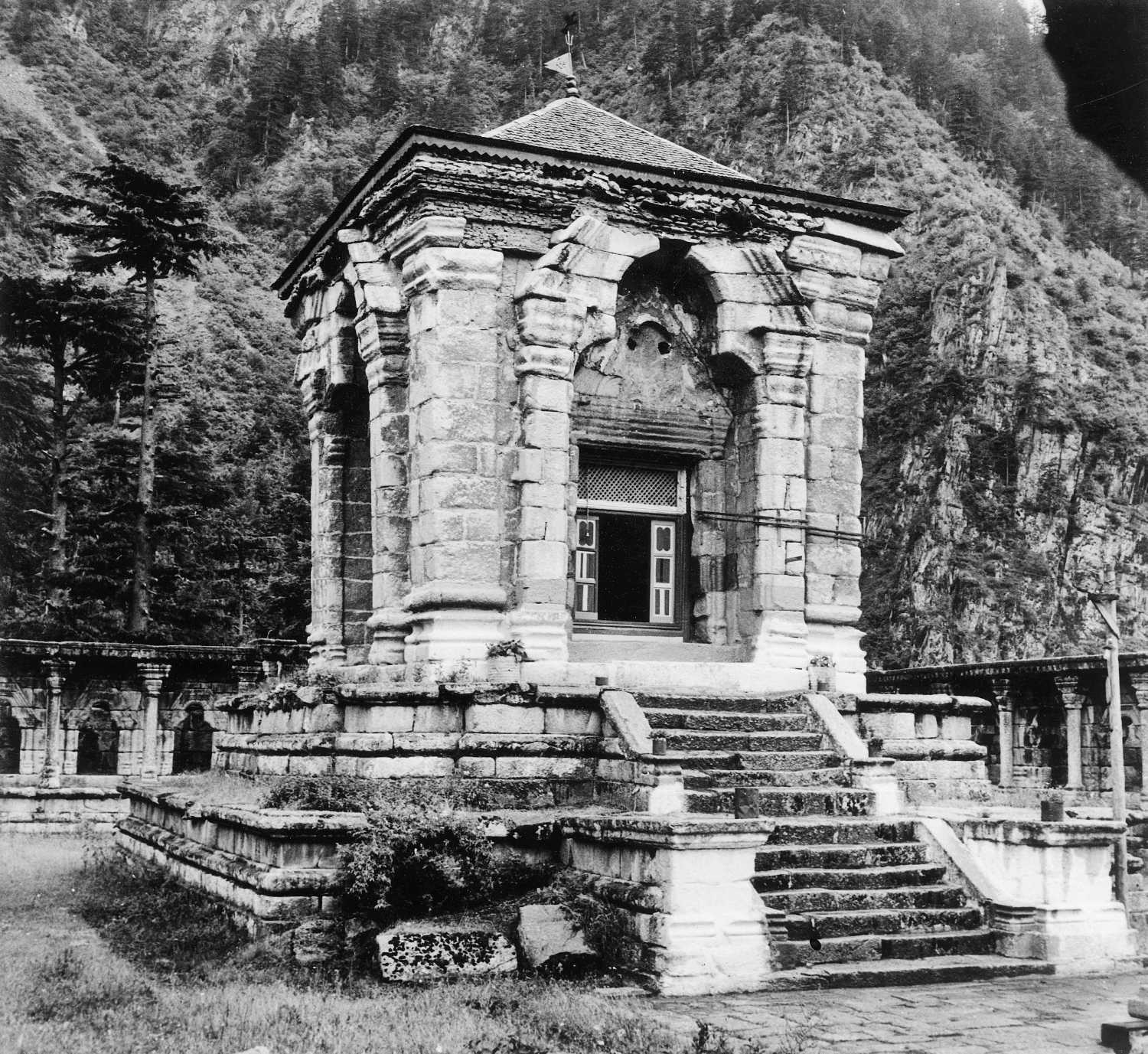
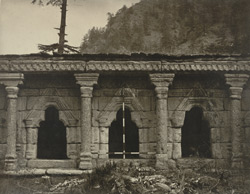 It is said that temple was constructed by Pandavas. However any
scripture claim to this is still unknown. It is said in 1868, an
archeologist Henry Hardy Cole arrived at this temple a Hindu Fakir told
him that this temple was built by Pandus. Also, another archeologist
James Fergusson confirmed that the colonnade of the temple was Gandhara
inspired. On the orders of Maharaja Ranbir Singh, this temple was
excavated; otherwise the temple remain untouched because it was claimed
by mountains and trees of that area. The temple was studied first by
Alexander Cunningham in Nov 1847. This temple was then called
"Bhawaniyaar" by the locals as they considered it to be a temple of
Bhawani. Due to winters the temple was then covered with snow hence his
study remained incomplete. Later the complete study of the temple was
made in 1865 by WG Cowie. He concluded that the temple walls were
supported on the basement of 4 ft.sq. The material used was pale coarse
granite. It is said because this material is not within the reaches of
the bank of Jhelum; hence it must have been carried down from valley. He
also suggested that the central temple was surrounded by water. Two old
wells have also been found near the temple. In his studies he also
noticed that near the upper base of the temple is the spout of a channel
which carried off the washings of an image which he wrote looked like
snake or similar animal.
It is said that temple was constructed by Pandavas. However any
scripture claim to this is still unknown. It is said in 1868, an
archeologist Henry Hardy Cole arrived at this temple a Hindu Fakir told
him that this temple was built by Pandus. Also, another archeologist
James Fergusson confirmed that the colonnade of the temple was Gandhara
inspired. On the orders of Maharaja Ranbir Singh, this temple was
excavated; otherwise the temple remain untouched because it was claimed
by mountains and trees of that area. The temple was studied first by
Alexander Cunningham in Nov 1847. This temple was then called
"Bhawaniyaar" by the locals as they considered it to be a temple of
Bhawani. Due to winters the temple was then covered with snow hence his
study remained incomplete. Later the complete study of the temple was
made in 1865 by WG Cowie. He concluded that the temple walls were
supported on the basement of 4 ft.sq. The material used was pale coarse
granite. It is said because this material is not within the reaches of
the bank of Jhelum; hence it must have been carried down from valley. He
also suggested that the central temple was surrounded by water. Two old
wells have also been found near the temple. In his studies he also
noticed that near the upper base of the temple is the spout of a channel
which carried off the washings of an image which he wrote looked like
snake or similar animal.
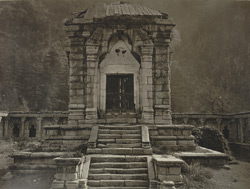
 In the book, Ancient Monuments in Kashmir, R.C Kak described the
temple: The gateway is a double-chambered structure faced on each open
side by a trefoil arch surmounted by a steep pediment. The lintels of
the closed arches are supported on pairs of columns which were
originally fluted, though the weather has now left no trace of flutes.
They have a double capital, the upper one being voluted on all four
sides. The walls are externally surmounted by a cornice of kirti-
mukhas, alternating with miniature trefoiled niches. Upon this rests the
first course of the pyramidal roof.
In the book, Ancient Monuments in Kashmir, R.C Kak described the
temple: The gateway is a double-chambered structure faced on each open
side by a trefoil arch surmounted by a steep pediment. The lintels of
the closed arches are supported on pairs of columns which were
originally fluted, though the weather has now left no trace of flutes.
They have a double capital, the upper one being voluted on all four
sides. The walls are externally surmounted by a cornice of kirti-
mukhas, alternating with miniature trefoiled niches. Upon this rests the
first course of the pyramidal roof.
The flights of steps-on the eastern and western sides respectively afford entrance to and exit from the entrance chamber. The one on the roadside is buried underground, but the inner stair has been excavated. It consists of seven steps flanked by sloping rails and upright side walls. Between this stair and the temple is a small stone platform which formed the lowermost course of the stepped base of a column (most probably a Garudadhvaja).
The priest in charge of the temple has now placed in it a small stele of very crude workmanship and late date, which he has painted with vermilion. Another similar stele, still standing in the position in which it was found, is seen in front of the temple stair. The temple itself stands on a double base, which is in every respect similar to other structures of its kind in Kashmir. A lofty trefoil arch, standing upon advanced pilasters and enclosing a rectangular entrance originally surmounted by an ornamental trefoil and steep pediment, gives access to the sanctum.
The jambs of the entrance are adorned with half-engaged columns. The interior is a square of 14 feet. The pedestal of the image is placed on a broad platform. The original image, which seems to have been of Vishnu, is now replaced by small Siva-lingas originally brought from the bed of the river Narbada. The walls are covered with a coat of modern whitewash. The string course from which the ceiling springs is still visible, but the ceiling itself which Bishop Cowie saw in 1865 and described as domical, has since either fallen down or been removed. It was, no doubt, similar to the ceilings of the larger temples at Wangath. Externally the only decorations are the trefoils of the recesses, their pediments, and the cornice of kirtimukhas and miniature trefoils from which the roof sprang. The quadrangle measures 145' by 119 1/2', and consists of fifty- three cells and the gateway. They are rectangular, 7' long by 4' broad. Each cell has a single trefoiled entrance enclosed in a high- pitched pediment resting on half-engaged columns. These ranges of cells are preceded by a noble colonnade which stands on a base similar to that of the temple. A transverse beam connects the capitals of the columns with the roof of the cells. Over these beams rises the entablature, only one course of which, namely the frieze of miniature trefoils, is extant. In the centre of each range of cells, except, perhaps, the one in which the gateway stands, is an apartment of larger dimensions preceded by a pair of taller columns which are advanced about 4' from the rest of the peristyle.
The top course of the cells is also decorated in the same way as the frieze above. On the south side, projecting from the cornice of the upper base of the temple, is the spout of the channel which carried off the washings of the image. It seems to have been shaped originally into a makara, or crocodile's head. Immediately below it is a huge water trough carved out of a single block of stone. The rain-water in the courtyard is carried off by a drain which runs under the south-eastern corner of the peristyle. In cell No. 11 of the north range, beginning the reckoning from the corner nearest the gateway, is the side entrance, which was then, as now, closed with a wooden door. The monotony of the external face of the western wall is partially relieved by rows of small square projections. In its two corners are two cells opening outwards. Immediately outside the side-door mentioned above is a square structure built of plain blocks of stone. The middle portion of each of its four walls has fallen down, and the gaps have been filled in with small chips of stone built in mud. It is difficult to surmise what was its original purpose.
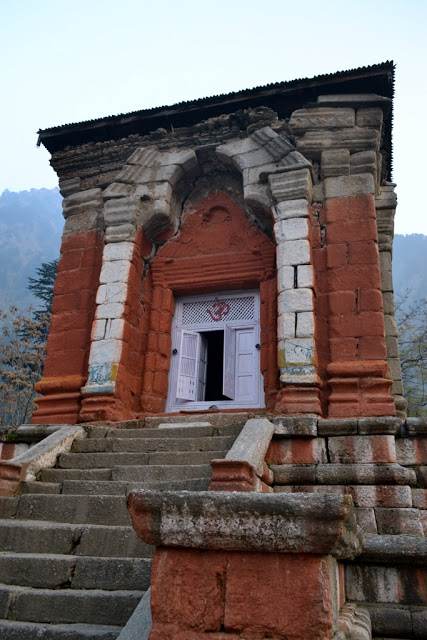
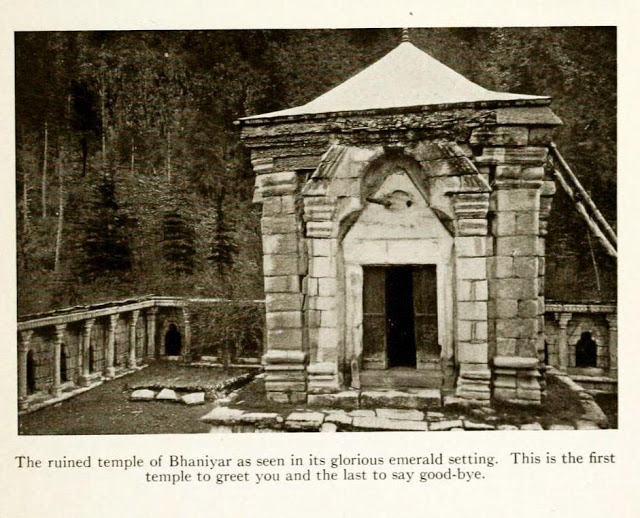
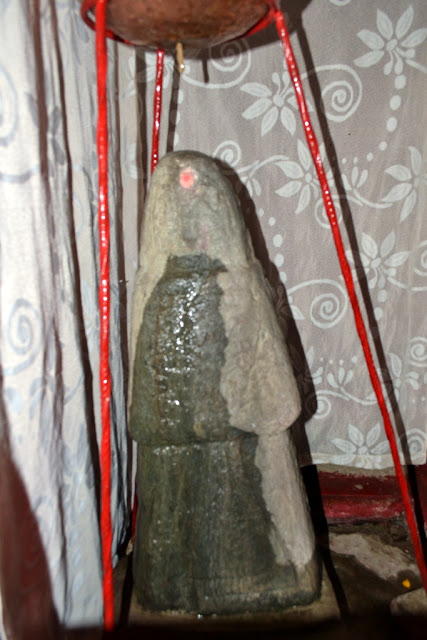
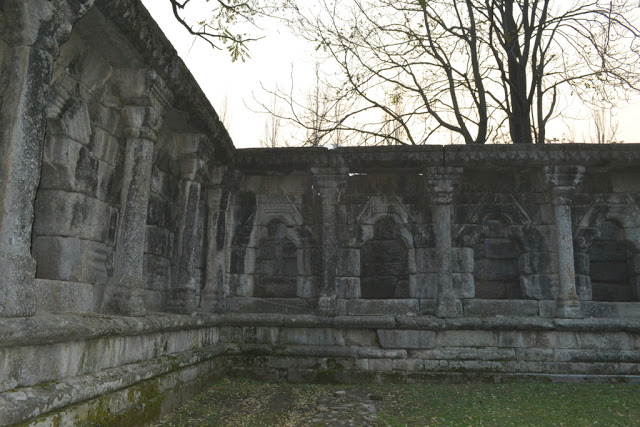



The flights of steps-on the eastern and western sides respectively afford entrance to and exit from the entrance chamber. The one on the roadside is buried underground, but the inner stair has been excavated. It consists of seven steps flanked by sloping rails and upright side walls. Between this stair and the temple is a small stone platform which formed the lowermost course of the stepped base of a column (most probably a Garudadhvaja).
The priest in charge of the temple has now placed in it a small stele of very crude workmanship and late date, which he has painted with vermilion. Another similar stele, still standing in the position in which it was found, is seen in front of the temple stair. The temple itself stands on a double base, which is in every respect similar to other structures of its kind in Kashmir. A lofty trefoil arch, standing upon advanced pilasters and enclosing a rectangular entrance originally surmounted by an ornamental trefoil and steep pediment, gives access to the sanctum.
The jambs of the entrance are adorned with half-engaged columns. The interior is a square of 14 feet. The pedestal of the image is placed on a broad platform. The original image, which seems to have been of Vishnu, is now replaced by small Siva-lingas originally brought from the bed of the river Narbada. The walls are covered with a coat of modern whitewash. The string course from which the ceiling springs is still visible, but the ceiling itself which Bishop Cowie saw in 1865 and described as domical, has since either fallen down or been removed. It was, no doubt, similar to the ceilings of the larger temples at Wangath. Externally the only decorations are the trefoils of the recesses, their pediments, and the cornice of kirtimukhas and miniature trefoils from which the roof sprang. The quadrangle measures 145' by 119 1/2', and consists of fifty- three cells and the gateway. They are rectangular, 7' long by 4' broad. Each cell has a single trefoiled entrance enclosed in a high- pitched pediment resting on half-engaged columns. These ranges of cells are preceded by a noble colonnade which stands on a base similar to that of the temple. A transverse beam connects the capitals of the columns with the roof of the cells. Over these beams rises the entablature, only one course of which, namely the frieze of miniature trefoils, is extant. In the centre of each range of cells, except, perhaps, the one in which the gateway stands, is an apartment of larger dimensions preceded by a pair of taller columns which are advanced about 4' from the rest of the peristyle.
The top course of the cells is also decorated in the same way as the frieze above. On the south side, projecting from the cornice of the upper base of the temple, is the spout of the channel which carried off the washings of the image. It seems to have been shaped originally into a makara, or crocodile's head. Immediately below it is a huge water trough carved out of a single block of stone. The rain-water in the courtyard is carried off by a drain which runs under the south-eastern corner of the peristyle. In cell No. 11 of the north range, beginning the reckoning from the corner nearest the gateway, is the side entrance, which was then, as now, closed with a wooden door. The monotony of the external face of the western wall is partially relieved by rows of small square projections. In its two corners are two cells opening outwards. Immediately outside the side-door mentioned above is a square structure built of plain blocks of stone. The middle portion of each of its four walls has fallen down, and the gaps have been filled in with small chips of stone built in mud. It is difficult to surmise what was its original purpose.

No comments:
Post a Comment